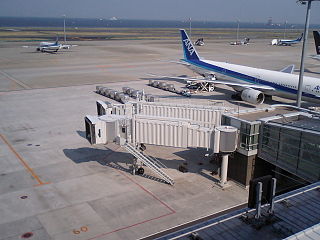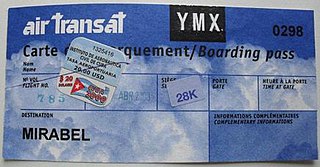
Detroit Metropolitan Wayne County Airport is the primary international airport serving Detroit and its surrounding metropolitan area in Michigan, United States. It is located in the City of Romulus and is Michigan's busiest airport.

A low-cost carrier or low-cost airline (LCC), also called no-frills, budget or discount carrier or airline, is an airline that is operated with an emphasis on minimizing operating costs. It sacrifices certain traditional airline luxuries, for cheaper fares. To make up for revenue lost in decreased ticket prices, the airline may charge extra fees such as for carry-on baggage. As of April 2020, the world's largest low-cost carrier is Southwest Airlines, which operates primarily in the United States, as well as in some surrounding areas.

A jet bridge is an enclosed, movable connector which most commonly extends from an airport terminal gate to an airplane, and in some instances from a port to a boat or ship, allowing passengers to board and disembark without heading outside and being exposed to harsh weather. Depending on building design, sill heights, fueling positions, and operational requirements, a jet bridge may be fixed or movable, swinging radially, and/or extending in length. The jetway was invented by Frank Der Yuen.

Business class is a travel class available on many commercial airlines and rail lines, known by brand names which vary, by airline or rail company. In the airline industry, it was originally intended as an intermediate level of service between economy class and first class, but many airlines now offer business class as the highest level of service, having eliminated first class seating. Business class is distinguished from other travel classes by the quality of seating, food, drinks, ground service and other amenities. In commercial aviation, full business class is usually denoted 'J' or 'C' with schedule flexibility, but can be many other letters depending on circumstances.

A boarding pass or boarding card is a document provided by an airline during airport check-in, giving a passenger permission to enter the restricted area of an airport and to board the airplane for a particular flight. At a minimum, it identifies the passenger, the flight number, the date, and scheduled time for departure. A boarding pass may also indicate details of the perks a passenger is entitled to and is thus presented at the entrance of such facilities to show eligibility.

Rigoberto Alpizar was a Costa Rican-born United States citizen who was fatally shot at Miami International Airport by two United States Federal Air Marshals.

Pisa International Airport, also named Galileo Galilei Airport, is an airport located in Pisa, Italy. It is one of the two major airports in Tuscany, the other being Florence Airport. Pisa is ranked 10th in Italy in terms of passenger numbers. It is named after Galileo Galilei, the famous scientist and native of Pisa. The airport was first developed for the military in the 1930s and 1940s. The airport was used by 5,233,118 passengers in 2017. It serves as a focus city of Ryanair.
A gate is an area in an airport terminal that controls access to a passenger aircraft. While the exact specifications vary from airport to airport and country to country, most gates consist of a seated waiting area, a counter and a doorway leading to the aircraft. A gate adjacent to the stand where the aircraft is parked may be a contact gate, providing access by way of a jet bridge, or a ground-loaded gate, providing a path for passengers to leave the building to board via mobile stairs or airstairs built into the aircraft itself. A remote gate serves an aircraft stand further away, providing access to ground transportation to move passengers between the gate and the stand, where they board via stairs.
Overselling or overbooking is sale of a volatile good or service in excess of actual supply. Overselling is a common practice in the travel and hospitality sectors, in which it is expected that some people will cancel. The practice occurs as an intentional business strategy in which sellers expect that some buyers will not consume all of the resources they are entitled to, or that some buyers will cancel. The practice of overselling aims to ensure that 100% of available supply will be used, resulting in the maximum return on investment. However, if more customers than the seller expects do wish to purchase or use the sold commodity, it may leave some customers lacking a service they expected to receive.

Ground support equipment (GSE) is the support equipment found at an airport, usually on the apron, the servicing area by the terminal. This equipment is used to service the aircraft between flights. As the name suggests, ground support equipment is there to support the operations of aircraft whilst on the ground. The role of this equipment generally involves ground power operations, aircraft mobility, and cargo/passenger loading operations.
On most modern airlines, flying standby is when a passenger awaits at the portline without a seat assignment waits at the gate to see if there is an extra seat after all scheduled passengers have boarded. There are several common circumstances in which passengers fly standby:

An airline seat is a seat on an airliner in which passengers are accommodated for the duration of the journey. Such seats are usually arranged in rows running across the airplane's fuselage. A diagram of such seats in an aircraft is called an aircraft seat map.

An aircraft cabin is the section of an aircraft in which passengers travel. Most modern commercial aircraft are pressurized, as cruising altitudes are high enough such that the surrounding atmosphere is too thin for passengers and crew to breathe.

Airport check-in is the process whereby an airline approves airplane passengers to board an airplane for a flight. Airlines typically use service counters found at airports for this process, and the check-in is normally handled by an airline itself or a handling agent working on behalf of an airline. Passengers usually hand over any baggage that they do not wish or are not allowed to carry in the aircraft's cabin and receive a boarding pass before they can proceed to board their aircraft.

An airline ticket is a document or electronic record, issued by an airline or a travel agency, that confirms that an individual is entitled to a seat on a flight on an aircraft. The airline ticket may be one of two types: a paper ticket, which comprises coupons or vouchers; and an electronic ticket.

Beirut–Rafic Hariri International Airport (Arabic: مطار رفيق الحريري الدولي بيروت, is the only operational commercial airport in Lebanon. It is located in the Southern Suburbs of Beirut, Lebanon, 9 kilometres from the city center. The airport is the hub for Lebanon's national carrier, Middle East Airlines and was the hub for the Lebanese cargo carrier TMA cargo and Wings of Lebanon before their respective collapses.

First class is a travel class on some passenger airliners intended to be more luxurious than business class, premium economy, and economy class. Originally all planes offered only one class of service, with a second class appearing first in 1955 when TWA introduced two different types of service on its Super Constellations.

Los Angeles International Airport has more than 150 gates in nine passenger terminals arranged in the shape of the letter U or a horseshoe. On the landside of the airport, LAX Shuttle route A buses allow passengers to move between all terminals. On the airside, various pedestrian corridors allow passengers to move between all terminals on foot without having to exit and reenter airport security. Additionally, by early 2025, the airport will be served by the LAX Automated People Mover, which will connect terminals to one another on the landside, along with providing connections to the LAX Consolidated Rent-A-Car Facility, parking facilities, and the LAX/Metro Transit Center station, which will be served by the Los Angeles Metro Rail system and public bus routes. In addition to these terminals, there are 2 million square feet (190,000 m2) of cargo facilities.
The Steffen Boarding Method, also known as the Steffen Perfect or simply the Steffen Method is a proposed "perfect aeroplane boarding method" that would enable optimally fast and convenient way of sequencing passengers. The method was first introduced by astrophysicist Jason Steffen in 2008.

Gate lice is a pejorative term used to describe a phenomenon observed among air travelers, where passengers gather in front of boarding gates before their designated boarding time. The term has gained recognition within the community of frequent flyers, particularly on platforms such as Flyertalk. This phenomenon may make the boarding process more cumbersome. For instance, it can lead to congestion, longer wait times for those who have prioritized boarding, and confusion. To avoid behaving in this manner, it is recommended to stay in one's seat until one's boarding zone is called.



















